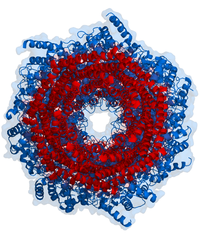
Photo from wikipedia
Congenital erythropoietic porphyria (CEP) is an inborn error of heme biosynthesis characterized by uroporphyrinogen III synthase (UROS) deficiency resulting in deleterious porphyrin accumulation in blood cells responsible for hemolytic anemia… Click to show full abstract
Congenital erythropoietic porphyria (CEP) is an inborn error of heme biosynthesis characterized by uroporphyrinogen III synthase (UROS) deficiency resulting in deleterious porphyrin accumulation in blood cells responsible for hemolytic anemia and cutaneous photosensitivity. We analyzed here the molecular basis of UROS impairment associated with twenty nine UROS missense mutations actually described in CEP patients. Using a computational and biophysical joint approach we predicted that most disease-causing mutations would affect UROS folding and stability. Through the analysis of enhanced green fluorescent protein-tagged versions of UROS enzyme we experimentally confirmed these data and showed that thermodynamic instability and premature protein degradation is a major mechanism accounting for the enzymatic deficiency associated with twenty UROS mutants in human cells. Since the intracellular loss in protein homeostasis is in excellent agreement with the in vitro destabilization, we used molecular dynamic simulation to rely structural 3D modification with UROS disability. We found that destabilizing mutations could be clustered within three types of mechanism according to side chain rearrangements or contact alterations within the pathogenic UROS enzyme so that the severity degree correlated with cellular protein instability. Furthermore, proteasome inhibition using bortezomib, a clinically available drug, significantly enhanced proteostasis of each unstable UROS mutant. Finally, we show evidence that abnormal protein homeostasis is a prevalent mechanism responsible for UROS deficiency and that modulators of UROS proteolysis such as proteasome inhibitors or chemical chaperones may represent an attractive therapeutic option to reduce porphyrin accumulation and prevent skin photosensitivity in CEP patients when the genotype includes a missense variant.
Journal Title: Human Molecular Genetics
Year Published: 2017
Link to full text (if available)
Share on Social Media: Sign Up to like & get
recommendations!